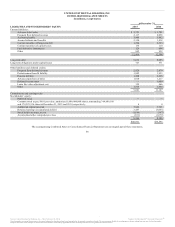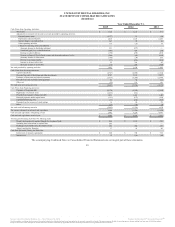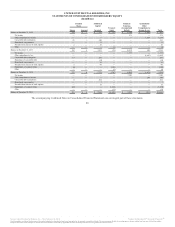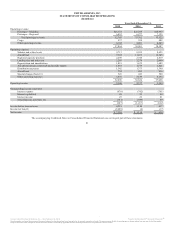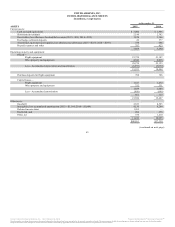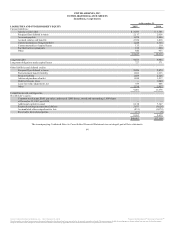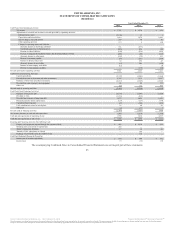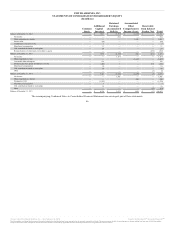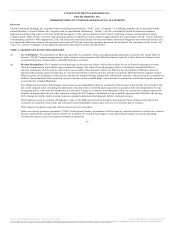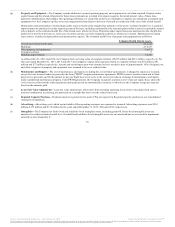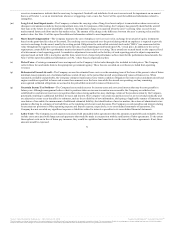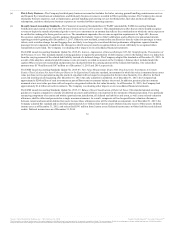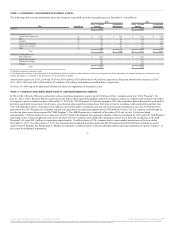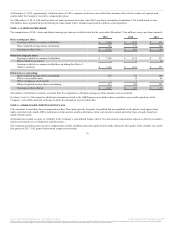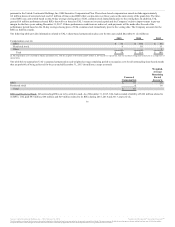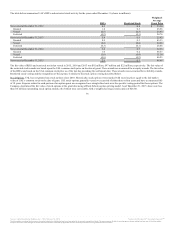United Airlines 2015 Annual Report Download - page 69
Download and view the complete annual report
Please find page 69 of the 2015 United Airlines annual report below. You can navigate through the pages in the report by either clicking on the pages listed below, or by using the keyword search tool below to find specific information within the annual report.
Accounts receivable primarily consist of amounts due from credit card companies and customers of our aircraft maintenance and cargo
transportation services. We provide an allowance for uncollectible accounts equal to the estimated losses expected to be incurred based on
historical write-offs and other specific analyses. Bad debt expense and write-offs were not material for the years ended December 31, 2015, 2014
and 2013.
(c) United’s MileagePlus program is designed to increase customer loyalty. Program participants earn miles by flying
on United and certain other participating airlines. Program participants can also earn miles through purchases from other non-airline partners that
participate in United’s loyalty program. We sell miles to these partners, which include credit card issuers, retail merchants, hotels, car rental
companies and our participating airline partners. Miles can be redeemed for free (other than taxes and government imposed fees), discounted or
upgraded air travel and non-travel awards. The Company records its obligation for future award redemptions using a deferred revenue model.
In the case of the sale of air services, the Company recognizes a portion of the ticket sales as revenue when the air transportation occurs and defers
a portion of the ticket sale representing the value of the related miles as a multiple-deliverable revenue arrangement. The miles are recorded in
Frequent flyer deferred revenue on the Company’s consolidated balance sheet and recognized into revenue when the transportation is provided.
The Company determines the estimated selling price of air transportation and miles as if each element is sold on a separate basis. The total
consideration from each ticket sale is then allocated to each of these elements individually on a pro rata basis.
The Company’s estimated selling price of miles is based on an equivalent ticket value less fulfillment discount, which incorporates the expected
redemption of miles, as the best estimate of selling price for these miles. The equivalent ticket value is based on the prior 12 months’ weighted
average equivalent ticket value of similar fares as those used to settle award redemptions while taking into consideration such factors as
redemption pattern, cabin class, loyalty status and geographic region. The estimated selling price of miles is adjusted by a fulfillment discount
that considers a number of factors, including redemption patterns of various customer groups.
United has a significant contract, the Consolidated Amended and Restated Co-Branded Card Marketing Services Agreement (the “Co-Brand
Agreement”), to sell MileagePlus miles to its co-branded credit card partner, Chase Bank USA, N.A. (“Chase”). United identified the following
significant revenue elements in the Co-Brand Agreement: the air transportation element represented by the value of the mile (generally resulting
from its redemption for future air transportation and whose fair value is described above); use of the United brand and access to MileagePlus
member lists; advertising; and other travel related benefits.
The fair value of the elements is determined using management’s estimated selling price of each element. The objective of using the estimated
selling price based methodology is to determine the price at which we would transact a sale if the product or service were sold on a stand-alone
basis. Accordingly, we determine our best estimate of selling price by considering multiple inputs and methods including, but not limited to,
discounted cash flows, brand value, volume discounts, published selling prices, number of miles awarded and number of miles redeemed. The
Company estimated the selling prices and volumes over the term of the Co-Brand Agreement in order to determine the allocation of proceeds to
each of the multiple elements to be delivered. We also evaluate volumes on an annual basis, which may result in a change in the allocation of
estimated selling price on a prospective basis.
68
Source: United Continental Holdings, Inc., 10-K, February 18, 2016 Powered by Morningstar® Document Research℠
The information contained herein may not be copied, adapted or distributed and is not warranted to be accurate, complete or timely. The user assumes all risks for any damages or losses arising from any use of this information,
except to the extent such damages or losses cannot be limited or excluded by applicable law. Past financial performance is no guarantee of future results.


